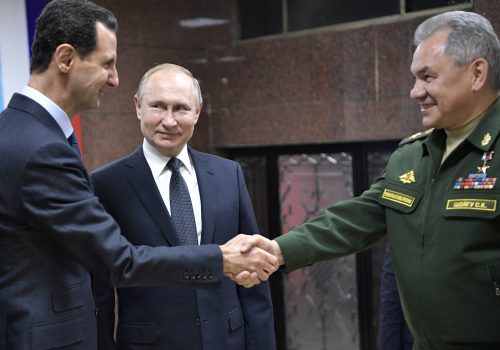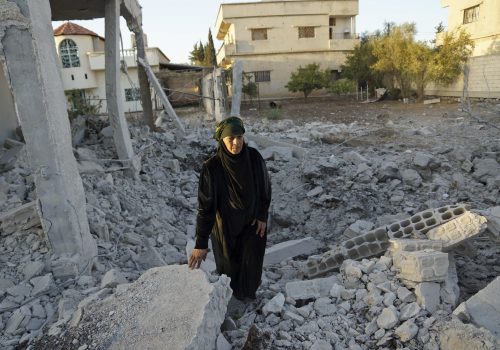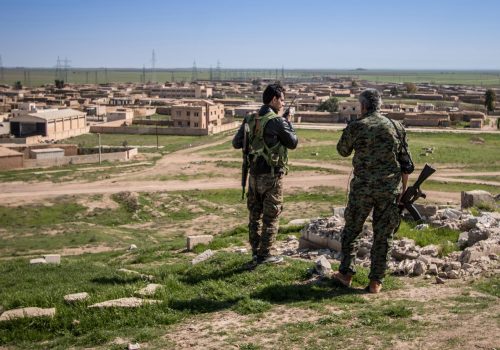Renewed hostilities in Daraa offer lessons and opportunities in Syria. But will Washington pay attention?
Renewed hostilities in Syria’s Daraa governorate have revealed cracks in prior deals made with opposition groups forcibly returned to pro-government rule. While it is correct that Syrian President Bashar al-Assad has won the war, continued opposition in Daraa proves that traditional centers of power in Damascus will hardly exercise absolute control across the country for the foreseeable future—if ever. Further, prolonged unrest in the south highlights rifts within the pro-Assad camp, notably between Iran and Damascus on one side and Russia on the other, potentially presenting a unique opportunity for diplomacy.
The underpinnings of the July 2018 reconciliation deal between the Assad regime and Daraa opposition groups, mediated by Moscow, personifies the conflicting interests between pro-Assad actors. The agreement stipulated that rebel groups hand over heavy weapons following a major offensive victory by pro-government forces that began in June 2018. Additionally, those who rejected the deal were forcibly displaced to the north, including hundreds of families from Daraa City and roughly six thousand individuals from neighboring Quneitra. Much of this is standard for rebel strongholds and did not produce animosity within the pro-Assad bloc.
This is where their agreement ends. The deal was unique because it allowed rebels some autonomy over certain Daraa areas via local councils, provided that Russia offered safety guarantees for fighters “settling their status” with the government by accepting Assad’s rule, and did not confiscate all weapons. Most importantly, military police overseen by Russia—not pro-government forces—would deploy alongside local forces to ensure security. Consequently, ex-rebels still controlled significant portions of the governorate, much to the dismay of Damascus and their Iranian allies like Hezbollah, who were looking to expand influence in areas of concern to Israel and Jordan. Deir ez-Zor province offers an excellent example of Iran’s efforts in this regard, which are blocked in Daraa by such deals.
Today, it is unsurprising that many rebels never accepted Assad’s attempts to encroach upon the deal and assert absolute control over Daraa. Instead, low-level fighting has occurred daily since 2018, with assassinations, bombings, and occasional small arms fire between rivals constituting the new norm. To be sure, score-settling is not unique to Daraa. Similar hostilities exist in many areas reclaimed by the Syrian government.
Hostilities reached a high point in recent months, stemming from the decision to boycott the May presidential election in multiple Daraa cities. Long-term hostilities and the Syrian government’s intentional deprivation of Daraa governorate, home to roughly one million people, have also played a role. Following the boycott, Damascus cut multiple areas in Daraa from supply lines on June 25, shuttering public utilities, humanitarian materials such as food and aid, and communications to cities still under the control of opposition groups. Facing continued resistance, Assad instituted a siege on the city on July 29, following minor hostilities in previous days. This resulted in a significantly worsened humanitarian crisis in an area struggling with inadequate housing and resources for Syrians and a sizeable Palestinian refugee population.
As a result of the siege, heavy fighting flourished in multiple Daraa areas, most intensely in the Daraa al-Balad district of roughly fifty thousand people. Various rebel groups fought pro-Assad forces consisting of Iran-backed militias and the Fourth Armored Division, largely supported by Iran and led by Assad’s brother, Maher. Many rebels rejected new Russian ceasefire deals that would have required them to give up small arms and displace those refusing the deal to the north until a similar ceasefire stipulating additional pro-government checkpoints was reached on Monday, September 6. Importantly, the regime rejected many previous deals, including a July 24 deal with rebels in Daraa al-Balad. In this case, Damascus considered the handover of weapons inadequate and increased its demands, calling for more security checkpoints staffed by their military forces in formerly rebel-controlled areas. Shortly after, the Fourth Division attempted to storm the city.
Such pro-government efforts are notable as Iran-backed groups and allied Syrian actors cooperate to achieve greater influence in Daraa. This is led by the Fourth Division, which has developed extensive ties with Iran while incorporating Shia armed groups, such as Liwas al-Imam al-Hussein, the Syrian branch of Harakat Hezbollah al-Nujaba. These groups have deep interests in crushing the remnants of the southern rebellion to exert their will, benefitting from pressure tactics during ceasefire negotiations—just as they did on July 24 and September 5.
This suggests that Iranian-aligned regime entities deliberately spoiled negotiations by shelling opposition areas and purposely agitating local communities following negotiations while regularly increasing demands in the process. This harmed trust between Moscow and opposition leaders on the ground and undoubtedly frustrated Russian officials who offered guarantees of safety in any deal. Worse, it was a cynical strategy from pro-Assad and pro-Iran actors designed to either prevent any ceasefire deal in the governorate or extract maximalist concessions. To be sure, some rebels also operated as spoilers, but hardly at the level of their pro-government rivals.
Attempts to spoil negotiations in Daraa were particularly important as they may have a depicted a public divergence of interests between Russia and Iran. Syrian officials close to Tehran, such as Syrian Defense Minister Ali Ayoub, were forthright in their goal of making Daraa bend to their rule. Ayoub even threatened to storm Daraa al-Balad, prompting his expulsion from the area by the Russian military. Damascus’ stance may also relate to its interest in re-building commercial relations with Jordan, recently mentioned by King Abdullah as an interest of both states. Renewed fighting in Daraa led Jordan to cancel the planned reopening of the Jaber-Nassib border crossing, blocking all movement of goods and people out of security concerns related to fighting and the presence of Iranian militias—a red line for Amman. Ultimately, constant hostilities with rebels in the area will not convince Jordan that it should open the border.
Moscow is simultaneously balancing its interest in propping up the Assad regime and preventing further Iranian encroachment in the south, which would harm its influence and invite a harsh Israeli response that would hurt Russia-Israel relations. Ultimately, the Russians view heightened Israeli tensions with Syria as detrimental to their goal of ending the war—a wise conclusion to reach. Russia certainly values its relations with Israel and does not view Iranian advancements in southern Syria as beneficial to that relationship or its interests in Syria. Furthermore, the Russians understand the value in balancing Syrian security and political dynamics—something Iran is purposely harming to further vassalize southern Syria for its geopolitical ambitions.
This divergence is likely causing headaches within the pro-Assad camp. Russian sources claimed in August that Damascus sent an envoy to Washington to discuss resumed cooperation between the regime and United States—if they accept Assad. This is supposedly a result of disagreements between Russian and Iranian officials on the situation in Daraa whereby the Syrian regime is attempting to solidify further southern gains by pitting Russian and American officials against each other. Essentially, Assad is signaling his displeasure with Russian actions in the south while capitalizing on a US interest in Israeli and Jordanian security. While the diplomatic overture is certainly dead-on-arrival, the public nature of the spat is a signal from Damascus to Moscow that speaks to the weight of the situation—even as Assad surely understands he must balance relations with Russia and Iran.
Still, a major rupture is not on the horizon and much of this could be performative by Russia. Regardless, Daraa’s context has presented an opportunity for the anti-Assad camp to conduct real diplomacy with actors like Russia to foster progress on the Syria file. Given Washington’s interest in verifiable cooperation with Moscow based on self-interest, alongside desires to pivot to Asia, the Joe Biden administration could use Moscow-Tehran tensions to engage Russian President Vladimir Putin and other major players in Syria to make progress on practical issues such as missing persons, chemical weapons, Kurdish support, or even a long-sought political transition. Until this is recognized, sporadic fighting in places like Daraa will continue, certainly appearing in other urban hubs that harbored the revolution, as a significant number of Syrians will continue to reject Assad’s rule.
Alexander Langlois is a foreign policy analyst focused on the Middle East and North Africa. He holds an MA in international affairs from American University’s School of International Service. Follow him on Twitter: @langloisajl.
Image: A fighter from the Free Syrian Army is seen in Yadouda area in Daraa, Syria May 29, 2018.REUTERS/ Alaa al Faqir


